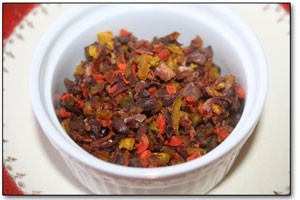
Roasted root risotto
by Ari Levaux
Root crops are the soul of a winter meal. But at this stage of the season, after months of playing around with these earthy, dense vegetables, many cooks are bored, having run out of ways to prepare them. Sometimes when you’re at such an impasse, all it takes is a new little trick to thrust open the creative doors. For me, learning to make a roasted root brunoise was just the ticket. It’s both a finished product that’s ready to be eaten, and an ingredient for other dishes, such as roasted root risotto.
Brunoise (“broon-wahh”), is French for “very small cubes.” It also functions as a verb, meaning “to cut things into very small cubes.” With roasted root brunoise, various brunoise-d roots are oven-roasted, which results in a fragrant mix of confetti-like colored bits of chewy roasted root.
 Munched plain, a mouthful of roasted root brunoise tastes a bit like those Terra brand “exotic vegetable chips” that come in fancy bags, though not as crispy. Roasted root brunoise can be sprinkled on salad, added to soup, fried with your breakfast, and used in many other ways.
Munched plain, a mouthful of roasted root brunoise tastes a bit like those Terra brand “exotic vegetable chips” that come in fancy bags, though not as crispy. Roasted root brunoise can be sprinkled on salad, added to soup, fried with your breakfast, and used in many other ways.
Most any tuber is fair game for a roasted brunoise. Whatever’s at the store, in your root cellar, or even still surviving in the garden deserves consideration. It can be a simple mix, like carrot and potato, or you can force the cashier to look up the codes for every obscure tuber in the produce section.
While roasting mellows and sweetens some fiery flavors, like that of a turnip, it will intensify others, like rutabaga, which becomes especially pungent when roasted. Radishes stay feisty, while shrivelling to the point of nearly disappearing. Carrot, celeriac and parsnip are especially perfumey. Taro and yam are starchy and sweet. Potatoes become starchy with a hint of bitterness. Beets are intense, earthy and sweet.
Depending on the context, caution is warranted with strong-flavored roots like radishes and rutabaga, which can really swing the flavor of a dish. Red beets, meanwhile, can give a crimson hue to everything they touch, thus, I would stick to the non-staining Chioggia (red and white stripped) or golden varieties. But that’s just me. Part of the fun of roasted root brunoise is experimenting with different roots and combinations.
True brunoise consists of perfect cubes of less than 1/8 inch per side. In culinary school, aspiring chefs are judged by their ability to create perfect brunoise in a timely manner. For our purposes, chopped really small will do, but it helps to at least attempt to do the chopping in a brunoise-like manner.
A sharp knife is essential. Peeling is optional, depending on the root in question and your preference.
The three main steps in making brunoise are: 1) cut your vegetable into thin sheets; 2) cut the sheets into matchsticks, or julienne; 3) cut your julienne into brunoise.
Your vegetable should always rest flat against the cutting board, so begin by cutting it in half and placing the two halves side by side, flat sides down. Slice the two halves lengthwise into sheets. Don’t be afraid to slice slowly, you don’t have to be all chopchopchopchop like the pros on TV. Your fingertips will thank you.
After cutting your two halved roots into sheets, arrange the sheets on the cutting board in piles, with flat sides down, like stacks of plywood. Slice these lengthwise into matchstick-like slivers, aka julienne.
Holding these piles together with one hand, turn the knife 90 degrees and chop the julienne crosswise into brunoise. If this is too confusing, numerous videos can be found online that demonstrate the process.
Because each type of root will cook at a different pace, it’s a good idea to keep each type of brunoise separate. Spread each variety onto a baking sheet or skillet, and bake at 350. Stir frequently, and remove each brunoise at the first sight of browning.
Now that you have your roasted root brunoise, you have options. Combine them into a colorful medley, sprinkle with salt, and start eating. Or use it as an ingredient in other ventures, such as the aforementioned
Roasted Root Risotto
2 cups roasted root brunoise
4 tablespoons butter or olive oil
1 medium onion, minced
4 cloves garlic, minced
½ cup sliced mushrooms
4 cups stock
½ teaspoon nutmeg
1 tablespoon garlic powder
1 teaspoon thyme
chili flakes (optional)
The brunoise should be completely cooled, preferably overnight. Heat butter or olive oil in a pan on medium heat, and sauté onion, garlic and mushrooms until the onion becomes translucent. Don’t let it brown.
Assemble two cups worth of roasted root brunoise. I like a mix of carrot, potato, celeriac, parsnip, and Chioggia or golden beet. Add the brunoise to the pan and mix it with the onions and garlic. Add two cups of stock and let it simmer uncovered until the stock almost evaporates. When the stock is almost gone, but before the pan dries out, add another cup of stock and stir. Season with salt, pepper, garlic powder, nutmeg, thyme and chili flakes if using.
Stir occasionally until the stock is again almost gone. Add the final cup of stock, and let it cook off, stirring occasionally to keep it from sticking.
This is a rich dish, perhaps best served as a side. Each bite delivers a different balance of the various components of the brunoise.
Leftovers can be refried with bacon and eggs in the morning. Meanwhile, whatever brunoise you happen to have left over can be stored in the fridge like a colorful supply of earth-toned pixie dust, ready to be scattered upon whatever is cooking.
